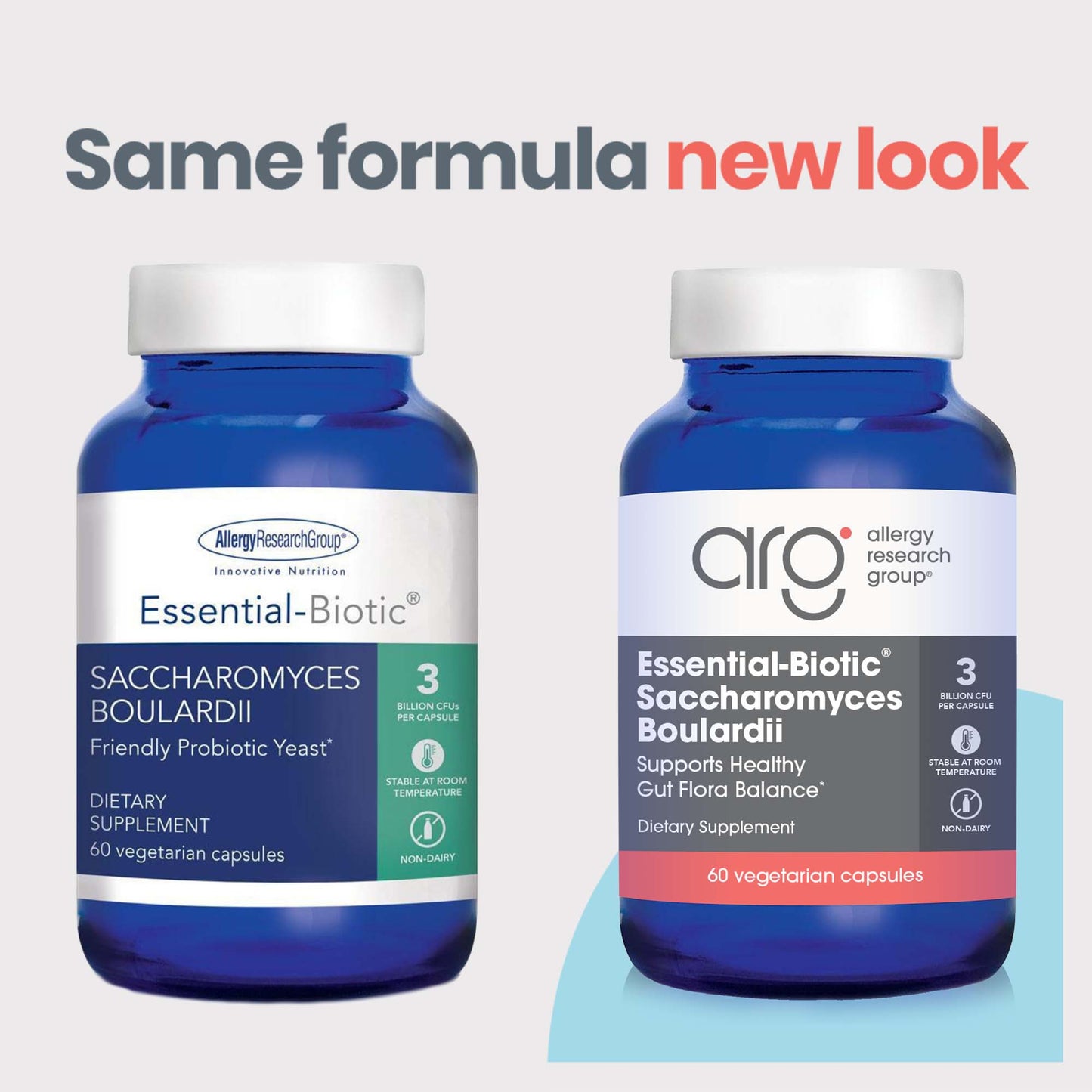













SKU:71050
Essential-Biotic® Saccharomyces Boulardii
Essential-Biotic® Saccharomyces Boulardii
Supports Healthy Gut Flora Balance*
Product Description
Essential-Biotic Saccharomyces Boulardii provides 9 billion CFU of a non-colonizing, acid-resistant probiotic yeast to support healthy bowel movements, gastrointestinal balance, and immune function.* Saccharomyces boulardii supports intestinal microbial balance, and secretory IgA and short-chain fatty acid production, and is well tolerated at clinically relevant doses.* It is a transitory microorganism and is eliminated after supplementation is stopped.*
Couldn't load pickup availability







-
Ingredients -
Product Information -
Suggested Use
Ingredients:
Serving Size: 3 capsules
Servings Per Container: 20 or 40
Amount per serving:
Saccharomyces boulardii (DBVPG 6763) 9 Billion CFUs: 450 mg
Other Ingredients:
Hydroxypropyl methylcellulose, microcrystalline cellulose, silicon dioxide, stearic acid.
Yeast-Based Probiotic for Gastrointestinal and Immune Health*
What It Does
Essential-Biotic Saccharomyces boulardii provides 450 mg (9 billion CFU) of Saccharomyces boulardii per serving which is a non-pathogenic, non-colonizing probiotic yeast that supports gastrointestinal function, microbial balance, and immune health in both adults and children.* It is well tolerated and appropriate for daily use or episodically for digestive support.*
How It Works
• Saccharomyces boulardii: A probiotic yeast that survives stomach acid and does not colonize the human GI tract, making it suitable for short- or long-term supplementation.*[1-3]
• Microbial Interaction: S. boulardii may bind to and neutralize microbial products in the intestinal lumen, supporting healthy bowel motility and microbial balance.*[4-7]
• Biofilm Disruption: Shown in preclinical studies to interact with microbial biofilms, aiding in microbial clearance and mucosal protection.*[8-9]
• Unique Protease Activity: Produces a protease capable of degrading certain microbial toxins and helping restore gut integrity.*[10-11]
• Immune Support: Enhances immune responses by increasing secretory IgA and short-chain fatty acid (SCFA) production, contributing to gut and systemic immune health.*[12-15]
• Well Tolerated: Human trials show efficacy and safety with daily doses ranging from 250 to 1,000 mg in various GI and immune contexts.*[16-26]
Who It’s For
Essential-Biotic Saccharomyces boulardii is ideal for individuals seeking microbial support to support immune and gut barrier function.*
Special Features
Unlike bacterial probiotics, Saccharomyces boulardii does not colonize the gut, making it uniquely positioned to support microbial balance without altering the resident microbiota.* Each capsule contains a research-backed dose for clinical flexibility.*
References
1. McFarland LV. World J Gastroenterol. 2010;16(18):2202–22.
2. Huang R, et al. Transl Pediatr. 2021;10(12):3248–60.
3. Liu LH, et al. BMC Infect Dis. 2023;23(1):878. doi:10.1186/s12879-023-08896-4
4. Martins FS, et al. J Gen Appl Microbiol. 2005;51(2):83–92.
5. Brandao RL, et al. Appl Environ Microbiol. 1998;64:564–8.
6. Vidon N, et al. Gastroenterol Clin Biol. 1986;10:1–4.
7. Ducluzeau R, et al. Ann Microbiol (Paris). 1982;133:491–501.
8. Jawhara S, Poulain D. Med Mycol. 2007;45(8):691–700.
9. Krasowska A, et al. FEMS Yeast Res. 2009;9(8):1312–21.
10. Castagliuolo I, et al. Infect Immun. 1996;64:5225–32.
11. Castagliuolo I, et al. Infect Immun. 1999;67:302–7.
12. Buts JP, et al. Pediatr Res. 2006;60:24–9. doi:10.1203/01.pdr.0000220322.31940.29
13. Vaishnavi C, et al. J Infect Dis. 2008;61(1):1–4.
14. Krause R, et al. Clin Diagn Lab Immunol. 2003;10(1):167–8.
15. Rodrigues AC, et al. J Appl Microbiol. 2000;89(3):404–14.
16. Ozkan TB, et al. J Int Med Res. 2007;35:201–12.
17. Oirard-Pipau F, et al. Microb Ecol Health Dis. 2002;14:220–27.
18. Schneider SM, et al. World J Gastroenterol. 2005;11:6165–9.
19. Kollaritsch H, et al. Travel Med Internatl. 1989;7:9–18.
20. Kollaritsch H, et al. Fortschr Med. 1993;111:152–6.
21. Guslandi M, et al. Eur J Gastroenterol Hepatol. 2003;15(6):697–8.
22. Garcia Vilela E, et al. Scand J Gastroenterol. 2008;43:842–8.
23. Plein K, Hotz J. Z Gastroenterol. 1993;31:129–34.
24. Guslandi M, et al. Dig Dis Sci. 2000;45:1462–4.
25. Surawicz CM, et al. Gastroenterology. 1989;96(4):981–8.
26. McFarland LV. World J Gastroenterol. 2010;16(18):2202–22.
Suggested use:
As a dietary supplement, take 3 capsules daily between meals, or as directed by a healthcare practitioner.
Warning:
If you are pregnant or lactating, have any health condition or are taking any medication, consult your healthcare practitioner before use.
Store in a cool, dry place, tightly capped, away from light. Keep out of the reach of children. Use only if safety seal is intact. Variations in product color may occur.
Stay Connected
Sign up and we’ll keep you up to date on the latest news, clinical education resources, product innovations and promotions.
